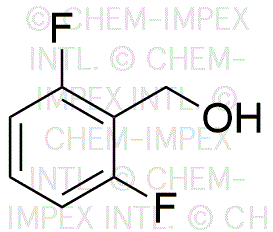2,6-Difluorobenzyl alcohol is widely utilized in research focused on:
- Pharmaceutical Development: This compound serves as a key intermediate in the synthesis of various pharmaceuticals, particularly in the development of drugs targeting neurological disorders.
- Organic Synthesis: It is employed in organic chemistry as a versatile building block for creating complex molecules, enhancing the efficiency of synthetic pathways.
- Material Science: Used in the formulation of specialty polymers and resins, it contributes to materials with improved thermal and chemical resistance.
- Biochemical Research: The compound is utilized in studies involving enzyme inhibition and receptor binding, providing insights into biological mechanisms and potential therapeutic targets.
- Flavor and Fragrance Industry: Its unique aromatic properties make it a valuable ingredient in the formulation of fragrances and flavoring agents, appealing to manufacturers looking for distinctive scent profiles.
General Information
Properties
Safety and Regulations
Applications
2,6-Difluorobenzyl alcohol is widely utilized in research focused on:
- Pharmaceutical Development: This compound serves as a key intermediate in the synthesis of various pharmaceuticals, particularly in the development of drugs targeting neurological disorders.
- Organic Synthesis: It is employed in organic chemistry as a versatile building block for creating complex molecules, enhancing the efficiency of synthetic pathways.
- Material Science: Used in the formulation of specialty polymers and resins, it contributes to materials with improved thermal and chemical resistance.
- Biochemical Research: The compound is utilized in studies involving enzyme inhibition and receptor binding, providing insights into biological mechanisms and potential therapeutic targets.
- Flavor and Fragrance Industry: Its unique aromatic properties make it a valuable ingredient in the formulation of fragrances and flavoring agents, appealing to manufacturers looking for distinctive scent profiles.
Documents
Safety Data Sheets (SDS)
The SDS provides comprehensive safety information on handling, storage, and disposal of the product.
Product Specification (PS)
The PS provides a comprehensive breakdown of the product’s properties, including chemical composition, physical state, purity, and storage requirements. It also details acceptable quality ranges and the product's intended applications.
Certificates of Analysis (COA)
Search for Certificates of Analysis (COA) by entering the products Lot Number. Lot and Batch Numbers can be found on a product’s label following the words ‘Lot’ or ‘Batch’.
Número de catálogo
Número de lote/lote
Certificates Of Origin (COO)
This COO confirms the country where the product was manufactured, and also details the materials and components used in it and whether it is derived from natural, synthetic, or other specific sources. This certificate may be required for customs, trade, and regulatory compliance.
Número de catálogo
Número de lote/lote
Safety Data Sheets (SDS)
The SDS provides comprehensive safety information on handling, storage, and disposal of the product.
DownloadProduct Specification (PS)
The PS provides a comprehensive breakdown of the product’s properties, including chemical composition, physical state, purity, and storage requirements. It also details acceptable quality ranges and the product's intended applications.
DownloadCertificates of Analysis (COA)
Search for Certificates of Analysis (COA) by entering the products Lot Number. Lot and Batch Numbers can be found on a product’s label following the words ‘Lot’ or ‘Batch’.
Número de catálogo
Número de lote/lote
Certificates Of Origin (COO)
This COO confirms the country where the product was manufactured, and also details the materials and components used in it and whether it is derived from natural, synthetic, or other specific sources. This certificate may be required for customs, trade, and regulatory compliance.


